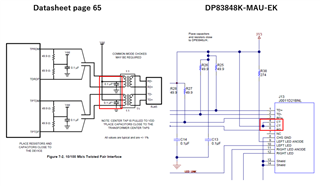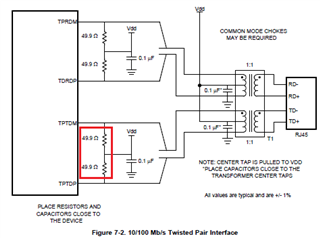Hello,
My customer tested the 100 Base-TX, UTP Differential Output Voltage (+Vout/-Vout) with DP83848K-MAU-EK EVM.
But these results ware failed.
(Test result:)
+Vout: Trial 1 (Worst): 1.0670 V, Trial 4: 1.0667 V, Trial 3: 1.0665 V (Total 6triais)
-Vout: Trial 5 (Worst): -1.0751 V, Trial 1: - 1.0749 V, Trial 2: -1.0698 V (Total 6triais)
Pass Limits:(950.0 mV to 1.0500 V)
(Test conditions:)
EVM: DP83848K-MAU-EK
Test equipment : DSO90804A(KEYSIGHT)
Probe: Model: 1130B(KEYSIGHT)
Disturber Source: 33250A (KEYSIGHT)
They tested other company PHY on same test conditions then both test was passed.
(Question)
(1)Does DP83848K confirmed to pass the 100 Base-TX, UTP Differential Output Voltage test with DP83848K-MAU-EK?
(2)About the center tap of pulse trans,
According to datasheet(65page), the decap is placed but it isn’t placed in DP83848K-MAU-EK.(Please refer below.)

Do you think this is the possible reason of test fail?
(3)Do you have any solution or idea? (ex. the change RBias value.)
(4)Could you please tell us possible reason?

Regards,
Tao_2199



